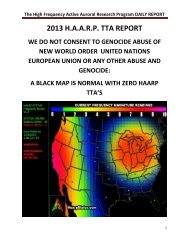fukushima-nuclear-disaster-tsunami-debris
fukushima-nuclear-disaster-tsunami-debris
fukushima-nuclear-disaster-tsunami-debris
Create successful ePaper yourself
Turn your PDF publications into a flip-book with our unique Google optimized e-Paper software.
FUKUSHIMA NUCLEAR DISASTER TSUNAMI DEBRIS<br />
The High Frequency Active Auroral Research<br />
Program ( HAARP) is an ionospheric research<br />
program jointly funded by the U.S. Air Force, the<br />
U.S. Navy, the University of Alaska, and the<br />
Defense Advanced Research Projects Agency<br />
Built by BAE Advanced Technologies (BAEAT), its<br />
purpose is to analyze the ionosphere and investigate<br />
the potential for developing ionospheric<br />
enhancement technology for radio communications<br />
and surveillance. [2] The HAARP program operates a<br />
major sub-arctic facility, named the HAARP<br />
Research Station, on an Air Force–owned site near<br />
Gakona, Alaska.<br />
The most prominent instrument at the HAARP<br />
Station is the Ionospheric Research Instrument (IRI),<br />
a high-power radio frequency transmitter facility<br />
operating in the high frequency (HF) band. The IRI<br />
is used to temporarily excite a limited area of the<br />
Ionosphere. Other instruments, such as a VHF and a<br />
UHF radar, a fluxgate magnetometer, a digisonde,<br />
and an induction magnetometer, are used to study<br />
the physical processes that occur in the excited<br />
region.<br />
5





